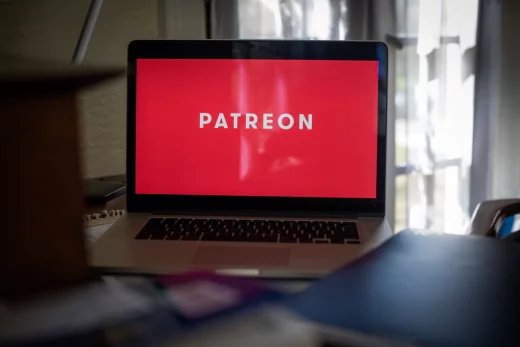
What is Patreon?
Creative freedom has always been an unaffordable luxury for artists looking to rise from humble backgrounds. Creators used to rely primarily on ad revenue and sponsorship ‘lucky breaks’ but then came Patreon – a new way for creators to gather financial support directly from their fans. But how much does Patreon take?
While Patreon does offer creators a new dimension of creative freedom – its services don’t come for free. The platform takes a share of creators’ earnings and uses different ways to make a profit.
Surely, Patreon is one of the most popular platforms and pretty much everyone on the internet knows about it. But there are many alternatives out there and each one has a different commission model. If you’re just starting out, it might be important for you to compare how big of a chunk out of your earnings you’re okay with setting aside for commission payments.
So, in this article, we’ll give you a deep dive into Patreon’s fee structure, as well as a side-by-side comparison with other platforms while we’re at it.
Understanding Patreon's fee structure

Here are the highlights of Patreon's fee structure and various features that come along. It has basically three pricing plans for creators depending on the size of your support base and how much extra value you want to provide to your fans.
- Lite Plan: For those who are just looking to offer recurring subscriptions to their fans, Lite Plan is all you need. Patreon takes 5% of everything you make if you go with this one.
- Pro Plan: Creators are usually too occupied with their work to talk to fans on a regular basis. Under the Pro Plan, Patreon provides priority customer support, unlimited app integrations and powerful analytics. All of this will cost you 8% of your monthly earnings.
- Premium Plan: Patreon can also take care of personalized merchandise with a dedicated partner manager under Premium Plan which also gets you everything in the Pro Plan. You can also have team accounts, customized coaching and much more for a 12% commission and a $300 monthly fee on top of it.
That’s not it. Patreon also charges processing fees that you might miss when signing up. Processing fees can be anywhere between 2.9% to 5% but there is also a small fixed fee for transactions initiated by you.
So Which Plan Should You Pick for Your Business?

Creators need to have a proper understanding of the actual effects of the respective pricing plans of Patreon on their business goals and for that, they need to take into account both the commissions and transaction processing fees.
Let’s start with the Lite Plan which comes with 5% commissions on your monthly earnings. As far as the processing fees are concerned, if your patrons are located in the United States the processing fee will be 2.9% along with $0.30 charges on every transaction and that takes the total paid to Patreon to roughly 7.9%.
In the Pro Plan, you’ll be paying around 10.9% and 14.9% in the Premium Plan of every donation payment from your US-based fans.
Patreon vs Other Crowdfunding Platforms

Patreon is not the only crowdfunding platform available for creators and monetization technology is constantly evolving. It’s worthwhile to compare it to other platforms before finding the best one for you:
Paysenger
Paysenger is a relatively new platform that offers a number of monetization tools to creators, including coaches, artists, musicians, bloggers, health experts and more. Users can make payments to you without any transaction fees as long as they use the platform’s native currency known as EGO tokens.
Some of the ways you can earn on Paysenger include:
- On-demand content: Offer exclusive content to fans, sponsors and idea makers. You don’t necessarily need to sell subscriptions (like Patreon) – others can simply go to your profile and request personalized content. For example, a sponsor looking for a shoutout can go to your profile and ask you to record a personalized video.
- Paid communication: Every interaction on Paysenger earns you tokens. To get your attention, people can send you paid direct messages for advice, business opportunities or just to say hi. You get paid for every message you reply.
- Tokenized contests and events: Paysenger uses a cryptocurrency known as EGO token to carry out all transactions. You can create full events, contests and hashtag challenges to drive engagement from the community. You earn tokens for going viral.
Indiegogo
Indiegogo helps raise funds for both new projects and ongoing campaigns with flexibility, support and global outreach. Indiegogo is quite similar to Kickstarter, if you know how it works. It charges 5% commissions, a 2.9% processing fee coupled with $0.30 charges on each transaction.
Ko-fi
Whether you’re looking for project-based funding, want to meet startup expenses or just recurring donations from your fans, Ko-fi is one of the best tools available.
And the best part is that it does all that without any commissions. Ko-fi earns income through its Gold Plan for big-volume creators who are looking to sell both digital and physical products. The Gold Plan costs $6 per month with some payment processing fees.
Buy Me a Coffee
In case you find Ko-fi’s interface challenging or have higher transaction fees, Buy Me a Coffee offers all crowdfunding features without commission. If you’re looking to create a personalized shop and additional rewards for your fans, you can get that by signing up to a premium plan for $5 per month.
New creators often think about pricing plans in isolation and lose sight of features and user experience so choose wisely!
How to Maximize Your Earnings on Patreon

Creators sometimes struggle to handle the business-side of things so here are a few suggestions to make the most out of Patreon.
Exclusive rewards
Fans love to have a personalized connection so build your Patreon tiers and offer exclusive rewards to your biggest patrons. They will keep coming back for more.
Stay connected with fans
The whole point of fans donating to you every month is that they expect to hear back from you. Provide them with exclusive content for their support and do shoutouts now and then.
Promote your Patreon
To grow your patronage, invite your followers from other networks to support you on Patreon. Patreon’s primary model requires creators to offer “premium” content in addition to free content on other sites like YouTube.
Most creators promote their Patreon page in YouTube videos or other platforms where they’re already offering free content. Followers must have an incentive to support you on Patreon – they must be getting something new and extra on Patreon that’s not already available in your free content.
However, promoting your Patreon page repeatedly might become problematic. There’s an entire sea of creators out there who are all offering some kind of subscription on Patreon. And over the years, the audiences have become used to it. For most people, it’s simply impractical to commit to a recurring subscription for each creator they follow, so there’s a limit to how many people you can bring to your Patreon.
Paysenger solves this problem by allowing creators to offer one-time exclusive content (instead of recurring subscriptions) that require commitment from users as well as the creator (to offer regular premium content).
On Paysenger you can earn money for:
- Providing one-time exclusive content, including videos, audios and photos
- Replying to paid messages
- Doing collaborations with other creators
- Bringing other people’s content ideas to life
Expand your revenue base
Don’t put your eggs in one basket! Use other monetization features on Patreon in addition to subscriptions such as merchandise sales and other one-time donations.
Creators should also secure brand partnerships or try affiliate marketing tools as well to increase their earning potential.
Diversifying Your Income Sources

You don’t have to rely solely on Patreon for income! There are other ways to generate steady income and you can combine them.
Open a Paysenger account
On Paysenger, you can sell on-demand content to your fans or take sponsorship requests from brands and companies. Paysenger is not only a subscription platform (like Patreon) but rather a full social networking platform that allows you to grow your following. On Patreon, you’re required to post free content to find an audience on platforms like YouTube.
This forces you to create content not only on Patreon but also on YouTube at the same time which might not be feasible for new creators. On Paysenger, you can offer everything in one place and grow your followers at the same time as you earn revenue through subscription, one-time requests and sponsorships.
The platform basically offers all monetization tools in one place.
Open a digital store
You can sell anything from clothing, handbags, tech to digital services, software and even NFTs by setting up a store. Services like Gumroad and Shopify make it super easy for creators to open merch stores. Don’t forget to promote your store through your content!
Affiliate marketing
Combine digital store sales with affiliate marketing. With affiliate marketing, you can sell other people’s products as well through platforms like Amazon and Etsy.
Affiliate marketers earn commission whenever someone buys a product through an affiliate link. It’s a popular way for creators to boost their income without needing to set up their own store.
Brand sponsorships
Gone are the days when brand sponsorships were only limited to the celebrity types. Even with a small niche audience as a nano influencer, you can easily win brand sponsorships and get paid by companies looking to promote their products and services.
However, make sure the brand you’re promoting has the same values as your content otherwise your audiences might call you a sell-out!
Sell courses
Your knowledge and expertise are what made you popular in the first place. If your audiences love your content, it means that you have a certain skill that they don’t.
Monetize your knowledge by turning it into a course and selling it on platforms like Udemy and Coursera.
Sell ads
Lastly, ad revenue is the most common tool at your disposal to make money by showing ads on your content.
YouTube has one of the best Partner Programs that automatically runs ads on your videos round-the-clock. If you’re a blogger, use Google Adsense to place ads on your website.
Instagram and TikTok also have their own creator programs that you can enroll in to generate earnings based on video views.
Frequently asked questions about Patreon

Are Patreon commission payments tax-deductible?
Yes, according to all federal and state laws, business expenses such as Patreon fees are tax deductible.
What if I want to change my Patreon Plan later?
Your Patreon plan can easily be changed at any time without any additional costs. However, this impacts your business goals so choose wisely.
Does Patreon collect VAT from creators?
Patreon is required by law to collect sales tax from creators. Although Patreon has a completely automated system to collect VAT, a tax consultant can give you better guidance.
Conclusion

Patreon has helped a number of creators kick start their journey and turn their passion into steady income. However, with rising advertisement costs and intense competition, it’s worthwhile to combine Patreon with other platforms such as Paysenger to enhance your earnings.
Patreon has been the go-to subscription platform for almost a decade now and pretty much everyone on the internet knows about it. However, that means that Patreon is highly competitive and you might not see any serious earnings for a long-time until you establish yourself as a creator.
On Paysenger, on the other hand, you have to deal with fewer competitors as a newly-starting creator. In addition, the platform offers a very nice interface and AI features to collect donations from your followers for you.
Starting out as a creator in 2023? Use Paysenger to maximize your earnings. It’s a newer platform that provides you with all necessary monetization tools you need to succeed on your journey.
